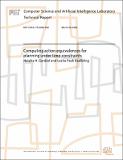| dc.contributor.advisor | Leslie Kaelbling | |
| dc.contributor.author | Gardiol, Natalia H. | |
| dc.contributor.author | Kaelbling, Leslie Pack | |
| dc.contributor.other | Learning and Intelligent Systems | |
| dc.date.accessioned | 2006-03-20T19:23:27Z | |
| dc.date.available | 2006-03-20T19:23:27Z | |
| dc.date.issued | 2006-03-20 | |
| dc.identifier.other | MIT-CSAIL-TR-2006-022 | |
| dc.identifier.uri | http://hdl.handle.net/1721.1/31337 | |
| dc.description.abstract | In order for autonomous artificial decision-makers to solverealistic tasks, they need to deal with the dual problems of searching throughlarge state and action spaces under time pressure.We study the problem of planning in domains with lots of objects. Structuredrepresentations of action can help provide guidance when the number of actionchoices and size of the state space is large.We show how structured representations ofaction effects can help us partition the action space in to a smallerset of approximate equivalence classes. Then, the pared-downaction space can be used to identify a useful subset of the state space in whichto search for a solution. As computational resources permit, we thenallow ourselves to elaborate the original solution. This kind of analysisallows us to collapse the action space and permits faster planning in muchlarger domains than before. | |
| dc.format.extent | 27 p. | |
| dc.format.extent | 418358 bytes | |
| dc.format.extent | 3755323 bytes | |
| dc.format.mimetype | application/pdf | |
| dc.format.mimetype | application/postscript | |
| dc.language.iso | en_US | |
| dc.relation.ispartofseries | Massachusetts Institute of Technology Computer Science and Artificial Intelligence Laboratory | |
| dc.title | Computing action equivalences for planning under time-constraints | |
